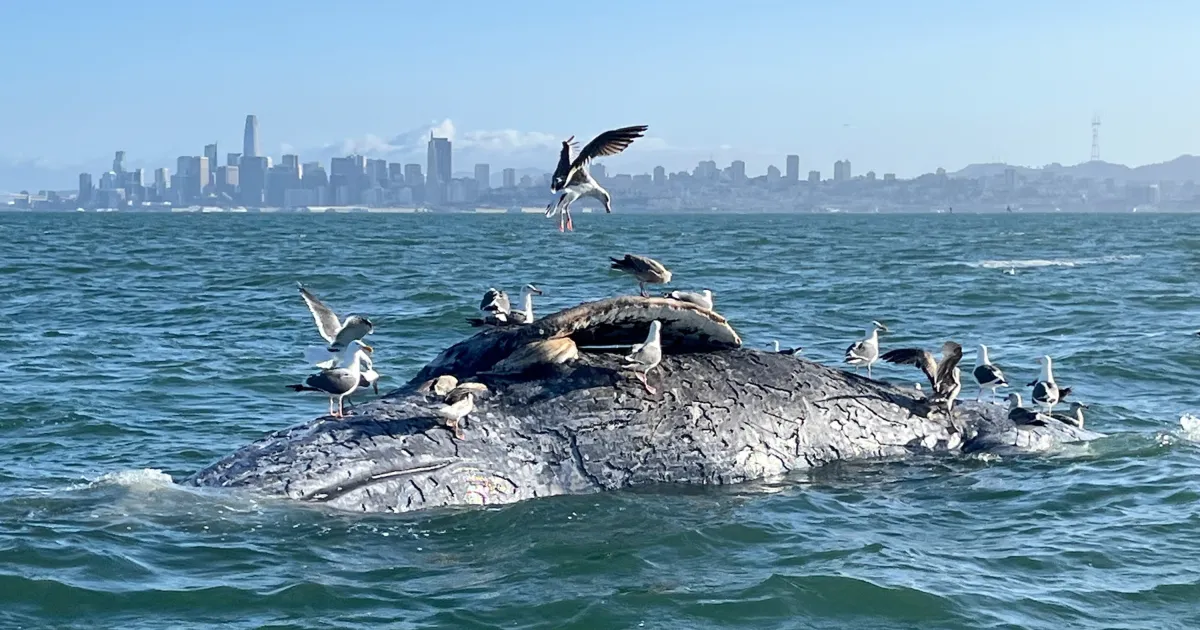Just days after a gray whale washed ashore at a beach in the Marin Headlands, two more carcasses were found last week in the San Francisco Bay. Three dead whales in the bay in one week is far out of the norm, experts say.
A group of researchers from the California Academy of Scientists and the Marine Mammal Center announced Tuesday that they were unable to determine what had killed a whale found April 1 near Angel Island but that a vessel strike likely killed the other — well-known to members of the whale-watching community, who had nicknamed it Denali.
“Three dead gray whales in a week — we have not seen that since 2021, when we had four,” said Giancarlo Rulli, The Marine Mammal Center’s associate public relations director. “That is a cause for concern.”
A fourth whale, believed to be a juvenile minke whale, was euthanized Tuesday after appearing to be stranded in an offshore mudflat near Emeryville. “This was an individual that was suffering,” Rulli said. The carcass reported April 1 at Angel Island State Park was an adult male, with evidence that it had been dead for some time.
The U.S. Army Corps of Engineers towed the carcass to Angel Island State Park, where scientists conducted a necropsy. The results were inconclusive. Rulli said the whale “was not in poor body condition” and had been actively feeding prior to its death. Rulli said the animal was lying on its left side, so the team was able to examine only one side. They did not find signs of contusions, fractures, or blunt-force trauma but “can’t rule it out completely until the carcass continues to decompose.”
Another whale — recognized by researchers as the sub-adult male Denali, named for a white patch on his left side resembling the state of Alaska — was reported Friday morning off Fort Point Rock Beach. Initially, the carcass was in an inaccessible area but was recovered by the team. The necropsy ruled that the cause of death was a probable vessel strike.
“What was immediately apparent was on the animal’s left side, there was a 7.5-foot laceration,” said Rulli. The team was unable to identify whether the laceration had occurred before or after the animal’s death.
“What they did find, and what we are able to say, is that there were six fractured spinal vertebrae, and there was hemorrhaging of the tissue around the spine,” said Rulli. “That is consistent with blunt-force trauma due to [a] vessel strike.”
Denali had been spotted in the bay March 28. The whale was in good condition, not emaciated or malnourished, according to Rulli.
These two deaths follow that of a female gray whale, spotted March 30 along the shore at Black Sands Beach in Marin after being seen floating around Alcatraz Island the day prior. It marked the first sighting of a dead whale in the Bay Area in 2025. That whale’s cause of death is undetermined.
Along the California coast, there have been a total of five whale strandings this year— the other two were in San Luis Obispo, with the causes of death undetermined.
Between 2018 and 2023, the gray whale species underwent what the National Oceanic and Atmospheric Administration called an unusual mortality event. Largely driven by climate change, the die-off was spurred by a combination of changes to the food source, entanglement, orca predation, and vessel strikes, resulting in 690 gray whale strandings — 347 of which were in the United States. In 2021, Rulli said, there were sightings of 15 dead gray whales, the majority in the Bay Area.
“There continues to be a significant number of gray whale sightings in San Francisco Bay as this species continues their northern migration to their arctic feeding grounds,” Kathi George, director of cetacean conservation biology at The Marine Mammal Center, said in a statement.
Boaters have been asked to demonstrate extra caution.
“With the bay serving as a shared space for commerce and increasing whale activity, it’s vital that all boaters, from large commercial vessels to sailboats, be whale aware, and if you see a blow, go slow,” George added.
In the last two weeks, ferry operators have cut their engines after spotting a gray whale to allow it to pass safely before resuming their routes.
Over the weekend, the Coast Guard made broadcasts over marine frequencies every four hours to alert mariners to the presence of whales. The U.S. Coast Guard’s Vessel Traffic Service made temporary route changes, especially in the area east of Angel Island.
“The actions that the U.S. Coast Guard have taken in recent days in terms of altering routes, including for ferries east of Angel Island, where a majority of these sightings are occurring, is quite remarkable,” said Rulli. “This is a very rare action that’s being taken.
“These investigations and the citing data are vital to tell a wider story of how, in this case, gray whales are utilizing San Francisco Bay, and how we can work with industry groups and commerce at large to protect them while they’re here,” he added.
If you see a dead marine mammal, contact the California Academy of Sciences at 415-379-5381. If you spot a live marine mammal, contact The Marine Mammal Center at 415-289-7325.



